Yu Feng
TIMERIPPLE: Accelerating vDiTs by Understanding the Spatio-Temporal Correlations in Latent Space
Nov 15, 2025



Abstract:The recent surge in video generation has shown the growing demand for high-quality video synthesis using large vision models. Existing video generation models are predominantly based on the video diffusion transformer (vDiT), however, they suffer from substantial inference delay due to self-attention. While prior studies have focused on reducing redundant computations in self-attention, they often overlook the inherent spatio-temporal correlations in video streams and directly leverage sparsity patterns from large language models to reduce attention computations. In this work, we take a principled approach to accelerate self-attention in vDiTs by leveraging the spatio-temporal correlations in the latent space. We show that the attention patterns within vDiT are primarily due to the dominant spatial and temporal correlations at the token channel level. Based on this insight, we propose a lightweight and adaptive reuse strategy that approximates attention computations by reusing partial attention scores of spatially or temporally correlated tokens along individual channels. We demonstrate that our method achieves significantly higher computational savings (85\%) compared to state-of-the-art techniques over 4 vDiTs, while preserving almost identical video quality ($<$0.06\% loss on VBench).
VeriCoT: Neuro-symbolic Chain-of-Thought Validation via Logical Consistency Checks
Nov 06, 2025



Abstract:LLMs can perform multi-step reasoning through Chain-of-Thought (CoT), but they cannot reliably verify their own logic. Even when they reach correct answers, the underlying reasoning may be flawed, undermining trust in high-stakes scenarios. To mitigate this issue, we introduce VeriCoT, a neuro-symbolic method that extracts and verifies formal logical arguments from CoT reasoning. VeriCoT formalizes each CoT reasoning step into first-order logic and identifies premises that ground the argument in source context, commonsense knowledge, or prior reasoning steps. The symbolic representation enables automated solvers to verify logical validity while the NL premises allow humans and systems to identify ungrounded or fallacious reasoning steps. Experiments on the ProofWriter, LegalBench, and BioASQ datasets show VeriCoT effectively identifies flawed reasoning, and serves as a strong predictor of final answer correctness. We also leverage VeriCoT's verification signal for (1) inference-time self-reflection, (2) supervised fine-tuning (SFT) on VeriCoT-distilled datasets and (3) preference fine-tuning (PFT) with direct preference optimization (DPO) using verification-based pairwise rewards, further improving reasoning validity and accuracy.
Beyond Random Masking: A Dual-Stream Approach for Rotation-Invariant Point Cloud Masked Autoencoders
Sep 18, 2025Abstract:Existing rotation-invariant point cloud masked autoencoders (MAE) rely on random masking strategies that overlook geometric structure and semantic coherence. Random masking treats patches independently, failing to capture spatial relationships consistent across orientations and overlooking semantic object parts that maintain identity regardless of rotation. We propose a dual-stream masking approach combining 3D Spatial Grid Masking and Progressive Semantic Masking to address these fundamental limitations. Grid masking creates structured patterns through coordinate sorting to capture geometric relationships that persist across different orientations, while semantic masking uses attention-driven clustering to discover semantically meaningful parts and maintain their coherence during masking. These complementary streams are orchestrated via curriculum learning with dynamic weighting, progressing from geometric understanding to semantic discovery. Designed as plug-and-play components, our strategies integrate into existing rotation-invariant frameworks without architectural changes, ensuring broad compatibility across different approaches. Comprehensive experiments on ModelNet40, ScanObjectNN, and OmniObject3D demonstrate consistent improvements across various rotation scenarios, showing substantial performance gains over the baseline rotation-invariant methods.
ClusterFusion: Expanding Operator Fusion Scope for LLM Inference via Cluster-Level Collective Primitive
Aug 26, 2025

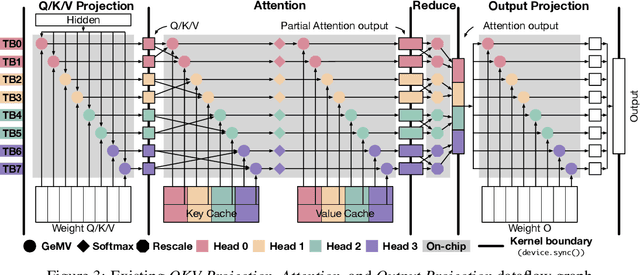

Abstract:Large language model (LLM) decoding suffers from high latency due to fragmented execution across operators and heavy reliance on off-chip memory for data exchange and reduction. This execution model limits opportunities for fusion and incurs significant memory traffic and kernel launch overhead. While modern architectures such as NVIDIA Hopper provide distributed shared memory and low-latency intra-cluster interconnects, they expose only low-level data movement instructions, lacking structured abstractions for collective on-chip communication. To bridge this software-hardware gap, we introduce two cluster-level communication primitives, ClusterReduce and ClusterGather, which abstract common communication patterns and enable structured, high-speed data exchange and reduction between thread blocks within a cluster, allowing intermediate results to be on-chip without involving off-chip memory. Building on these abstractions, we design ClusterFusion, an execution framework that schedules communication and computation jointly to expand operator fusion scope by composing decoding stages such as QKV Projection, Attention, and Output Projection into a single fused kernels. Evaluations on H100 GPUs show that ClusterFusion outperforms state-of-the-art inference frameworks by 1.61x on average in end-to-end latency across different models and configurations. The source code is available at https://github.com/xinhao-luo/ClusterFusion.
SMPL Normal Map Is All You Need for Single-view Textured Human Reconstruction
Jun 15, 2025Abstract:Single-view textured human reconstruction aims to reconstruct a clothed 3D digital human by inputting a monocular 2D image. Existing approaches include feed-forward methods, limited by scarce 3D human data, and diffusion-based methods, prone to erroneous 2D hallucinations. To address these issues, we propose a novel SMPL normal map Equipped 3D Human Reconstruction (SEHR) framework, integrating a pretrained large 3D reconstruction model with human geometry prior. SEHR performs single-view human reconstruction without using a preset diffusion model in one forward propagation. Concretely, SEHR consists of two key components: SMPL Normal Map Guidance (SNMG) and SMPL Normal Map Constraint (SNMC). SNMG incorporates SMPL normal maps into an auxiliary network to provide improved body shape guidance. SNMC enhances invisible body parts by constraining the model to predict an extra SMPL normal Gaussians. Extensive experiments on two benchmark datasets demonstrate that SEHR outperforms existing state-of-the-art methods.
STREAMINGGS: Voxel-Based Streaming 3D Gaussian Splatting with Memory Optimization and Architectural Support
Jun 09, 2025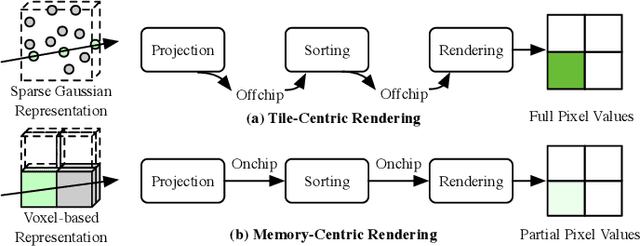



Abstract:3D Gaussian Splatting (3DGS) has gained popularity for its efficiency and sparse Gaussian-based representation. However, 3DGS struggles to meet the real-time requirement of 90 frames per second (FPS) on resource-constrained mobile devices, achieving only 2 to 9 FPS.Existing accelerators focus on compute efficiency but overlook memory efficiency, leading to redundant DRAM traffic. We introduce STREAMINGGS, a fully streaming 3DGS algorithm-architecture co-design that achieves fine-grained pipelining and reduces DRAM traffic by transforming from a tile-centric rendering to a memory-centric rendering. Results show that our design achieves up to 45.7 $\times$ speedup and 62.9 $\times$ energy savings over mobile Ampere GPUs.
Astraea: A GPU-Oriented Token-wise Acceleration Framework for Video Diffusion Transformers
Jun 06, 2025
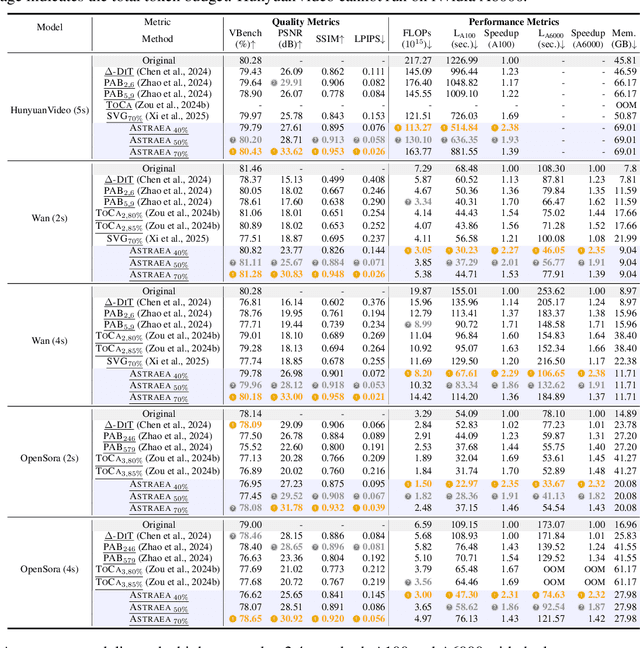
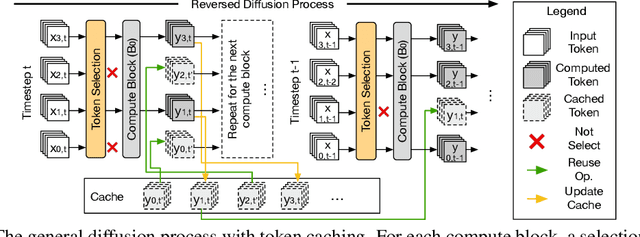
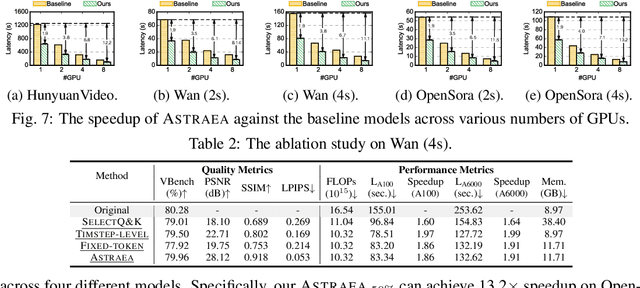
Abstract:Video diffusion transformers (vDiTs) have made impressive progress in text-to-video generation, but their high computational demands present major challenges for practical deployment. While existing acceleration methods reduce workload at various granularities, they often rely on heuristics, limiting their applicability. We introduce ASTRAEA, an automatic framework that searches for near-optimal configurations for vDiT-based video generation. At its core, ASTRAEA proposes a lightweight token selection mechanism and a memory-efficient, GPU-parallel sparse attention strategy, enabling linear reductions in execution time with minimal impact on generation quality. To determine optimal token reduction for different timesteps, we further design a search framework that leverages a classic evolutionary algorithm to automatically determine the distribution of the token budget effectively. Together, ASTRAEA achieves up to 2.4x inference speedup on a single GPU with great scalability (up to 13.2x speedup on 8 GPUs) while retaining better video quality compared to the state-of-the-art methods (<0.5% loss on the VBench score compared to the baseline vDiT models).
An Efficient Private GPT Never Autoregressively Decodes
May 21, 2025Abstract:The wide deployment of the generative pre-trained transformer (GPT) has raised privacy concerns for both clients and servers. While cryptographic primitives can be employed for secure GPT inference to protect the privacy of both parties, they introduce considerable performance overhead.To accelerate secure inference, this study proposes a public decoding and secure verification approach that utilizes public GPT models, motivated by the observation that securely decoding one and multiple tokens takes a similar latency. The client uses the public model to generate a set of tokens, which are then securely verified by the private model for acceptance. The efficiency of our approach depends on the acceptance ratio of tokens proposed by the public model, which we improve from two aspects: (1) a private sampling protocol optimized for cryptographic primitives and (2) model alignment using knowledge distillation. Our approach improves the efficiency of secure decoding while maintaining the same level of privacy and generation quality as standard secure decoding. Experiments demonstrate a $2.1\times \sim 6.0\times$ speedup compared to standard decoding across three pairs of public-private models and different network conditions.
Imputation-free and Alignment-free: Incomplete Multi-view Clustering Driven by Consensus Semantic Learning
May 16, 2025Abstract:In incomplete multi-view clustering (IMVC), missing data induce prototype shifts within views and semantic inconsistencies across views. A feasible solution is to explore cross-view consistency in paired complete observations, further imputing and aligning the similarity relationships inherently shared across views. Nevertheless, existing methods are constrained by two-tiered limitations: (1) Neither instance- nor cluster-level consistency learning construct a semantic space shared across views to learn consensus semantics. The former enforces cross-view instances alignment, and wrongly regards unpaired observations with semantic consistency as negative pairs; the latter focuses on cross-view cluster counterparts while coarsely handling fine-grained intra-cluster relationships within views. (2) Excessive reliance on consistency results in unreliable imputation and alignment without incorporating view-specific cluster information. Thus, we propose an IMVC framework, imputation- and alignment-free for consensus semantics learning (FreeCSL). To bridge semantic gaps across all observations, we learn consensus prototypes from available data to discover a shared space, where semantically similar observations are pulled closer for consensus semantics learning. To capture semantic relationships within specific views, we design a heuristic graph clustering based on modularity to recover cluster structure with intra-cluster compactness and inter-cluster separation for cluster semantics enhancement. Extensive experiments demonstrate, compared to state-of-the-art competitors, FreeCSL achieves more confident and robust assignments on IMVC task.
SnapPix: Efficient-Coding--Inspired In-Sensor Compression for Edge Vision
Apr 06, 2025Abstract:Energy-efficient image acquisition on the edge is crucial for enabling remote sensing applications where the sensor node has weak compute capabilities and must transmit data to a remote server/cloud for processing. To reduce the edge energy consumption, this paper proposes a sensor-algorithm co-designed system called SnapPix, which compresses raw pixels in the analog domain inside the sensor. We use coded exposure (CE) as the in-sensor compression strategy as it offers the flexibility to sample, i.e., selectively expose pixels, both spatially and temporally. SNAPPIX has three contributions. First, we propose a task-agnostic strategy to learn the sampling/exposure pattern based on the classic theory of efficient coding. Second, we co-design the downstream vision model with the exposure pattern to address the pixel-level non-uniformity unique to CE-compressed images. Finally, we propose lightweight augmentations to the image sensor hardware to support our in-sensor CE compression. Evaluating on action recognition and video reconstruction, SnapPix outperforms state-of-the-art video-based methods at the same speed while reducing the energy by up to 15.4x. We have open-sourced the code at: https://github.com/horizon-research/SnapPix.
 Add to Chrome
Add to Chrome Add to Firefox
Add to Firefox Add to Edge
Add to Edge